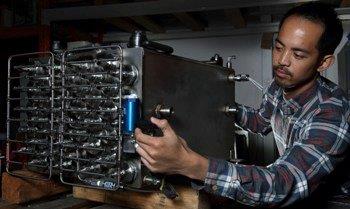 Adrian Narvaez of Hawaii Hydrogen Carriers with a metal hydride storage tank.
PHOTO: DINO VOURNAS |
A partnership between Sandia National Laboratories and Hawaii Hydrogen Carriers LLC (HHC) is developing a zero-emission hydrogen fuel cell system that may power forklifts at low cost with fast refueling times.
"Once you understand how these forklifts operate, the fuel cell advantage is clear," says Joseph Pratt with the energy systems engineering and analysis department at Sandia's Livermore facility.
HHC is developing technologies that may reduce costs and improve performance for the fuel cell forklift market. The company's low-pressure hydrogen storage system can be refueled at standard industrial gas pressures.
The HHC-initiated project aims to design a solid-state hydrogen storage system that can refuel at low pressure four to five times faster than it takes to charge a lead-acid forklift battery, giving hydrogen a competitive advantage over batteries for much of the clean forklift market.
Fuel cells power forklifts now, but Pratt explains a difference: "Current mass-marketed fuel cell forklift power packs, including those from Plug (Power Inc of Latham, New York), store hydrogen as a high-pressure gas at 5,000 pounds per square inch (psi). In order to achieve these high pressures, a hydrogen fuel cell forklift owner must install hydrogen storage and compression equipment at the warehouse, adding a significant cost of ownership. While a facility with many forklifts can divide this cost over all of their forklifts, for smaller installations with less than 10 forklifts, the cost of this equipment can be an obstacle to achieving a reasonable return on investment."
Based in Honolulu, Hawaii, HHC obtained a grant from the US Department of Energy (DOE)'s office of energy efficiency and renewable energy. HHC also received DOE small business innovative research grants of USD99,825 for phase I in 2010 and USD993,322 for phase II in 2011 and subcontracted some of the work to Sandia.
Sandia handled in-depth modeling and full-scale experiments to design the internal structure of the hydride-carrying tubes within the tank to achieve maximum hydrogen storage amounts. In addition, Sandia took the lead on system design to achieve faster fills and longer run times.
HHC was responsible for project management and logistics, system performance specifications, detailed design drawings and build, and integration of the tank with the Hydrogenics fuel cell power pack. HHC is responsible for conducting the demonstration.
To solidify the collaboration, HHC sent Adrian Narvaez to Sandia's combustion research facility in California for several months. "Joe and I work together every day on the design, so it's a huge advantage to be able to work on site at Sandia," Narvaez says.
The HHC technology uses a metal hydride to store the hydrogen, resulting in a maximum hydrogen pressure of just 750 psi. Pratt notes, "Because of this lower pressure, a facility can purchase or rent hydrogen gas cylinders directly from a local industrial gas supplier and use those to fill the forklift's tank with minimal additional equipment. This allows operators of small forklift fleets, down to one unit, a cost-effective entry into using hydrogen fuel cells for their forklifts."
The fuel cell portion of the power pack is generally the same as in Plug Power's product.
In this project, HHC has partnered with Plug Power competitor Hydrogenics Corp of Mississauga, Ontario, Canada to integrate the metal hydride tank into their fuel cell forklift power pack. However, the metal hydride hydrogen storage tank can replace the high-pressure tank in any manufacturer's fuel cell power pack.
Pratt says, "The finished hydrogen storage tank is currently being assembled into the fuel cell power pack. I anticipate that it will be shipped to the deployment site by the end of May with trials beginning in June or July."